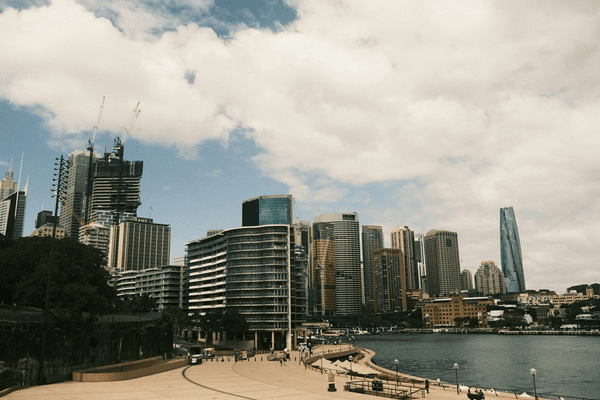
Share
Australian office market shows strong recovery signs in 2025 with positive absorption exceeding 100,000sqm, international investment surge, and hybrid work stabilisation driving demand.
After years of uncertainty and upheaval, the Australian office market is finally turning the corner in 2025. For the first time in three years, positive space absorption has exceeded 100,000 square metres, marking a pivotal moment for an industry that has weathered extraordinary challenges since the pandemic began.
This recovery story extends far beyond spreadsheet statistics. It represents fundamental shifts in how Australians work, where businesses choose to establish their presence, and how international investors perceive our commercial property market. From Sydney’s prestigious financial towers to Brisbane’s emerging corporate hubs, the landscape is transforming in ways that will reshape the sector for decades.
While headwinds persist around economic uncertainty and evolving workplace preferences, market indicators strongly suggest the worst is behind us. This analysis explores the key forces driving recovery, the regional dynamics creating new opportunities, and the insights property market followers need as we navigate 2025’s changing terrain.
Market momentum builds as absorption soars
The Australian office market’s turnaround can be measured through several compelling metrics that paint an increasingly positive picture. The latest Property Council of Australia office market report reveals positive take-up for both CBD and non-CBD markets totalled 118,756 square metres for the 12 months to January 2025. This milestone represents the first time absorption has exceeded 100,000 square metres in three years, signalling a decisive shift from the negative absorption that characterised the pandemic’s peak impact.
Investment confidence returns
This positive absorption reflects more than statistical improvement—it indicates businesses are expanding, relocating, and committing to physical office space after years of contraction. Companies have moved beyond survival mode and are planning for growth, with many recognising that quality office environments remain central to their operational success.
Investment activity provides another powerful indicator of renewed market confidence. Commercial property investment volumes are projected to surge by 15 per cent to $36 billion in 2025, with the office sector leading this charge through an anticipated 25 per cent increase in investment volumes. This dramatically outpaces the modest 10 per cent growth expected across industrial, retail, and hotel sectors, positioning office property as the standout performer in Australia’s commercial real estate landscape.
Supply constraints create opportunity
The vacancy rate picture, while still elevated, shows clear signs of stabilisation. National vacancy is expected to peak in 2025 before beginning its decline, driven primarily by a dramatic slowdown in new supply. The development pipeline across major Australian office markets has contracted substantially due to soaring construction costs and financing challenges, creating market conditions that strongly favour absorption of existing stock.
For property market followers, these indicators collectively suggest the market has reached its nadir. The recovery trajectory appears measured rather than explosive, with industry experts predicting steady improvement through 2025 and accelerating momentum into 2026.
Workplace evolution drives new demand patterns
The Australian workplace has undergone a fundamental transformation since 2020, with office market recovery intrinsically linked to how these changes are crystallising. Recent research reveals that 78 per cent of Australian employees favour a hybrid working model, with the average professional seeking to work from home at least 3.2 days per week. This represents a seismic shift from pre-pandemic norms when 57 per cent of workers preferred traditional office-based arrangements.
The hybrid stabilisation
Intriguingly, the percentage of Australians working from home has decreased slightly from 37 per cent in August 2023 to 36 per cent currently, marking the first decrease since COVID-19 emerged. This subtle but significant shift suggests the pendulum may be swinging back towards office-based work, though in a more balanced configuration than the pre-2020 era.
The most popular hybrid arrangement has emerged as four days in-office with one day remote, adopted by 28 per cent of organisations. Three days in-office follows closely at 26 per cent. This structured approach is fundamentally reshaping office space requirements, prompting companies to reconsider both the quantity and quality of space needed to serve their evolving workforce effectively.
Quality becomes the differentiator
The flight to quality is driving unprecedented change in tenant preferences. Companies are reimagining workspaces as destinations that attract employees through superior amenities—end-of-trip facilities, wellness areas, collaborative zones, and cutting-edge technology integration. This transformation is creating a stark divide between premium, well-appointed spaces experiencing robust demand and older or poorly located assets struggling to attract tenants.
Sublease availability has dropped to its lowest level since 2019, indicating that the major contractionary moves characterising the pandemic period have largely concluded. This stabilisation suggests businesses have completed their downsizing exercises and are now focused on rightsizing rather than simply reducing their physical footprints.
The return-to-office momentum is gaining strength, particularly influenced by policy changes from major US corporations implementing stricter attendance requirements. However, Australia’s approach appears more measured, with most organisations recognising that flexibility has become a permanent workforce expectation rather than a temporary accommodation.
Cities chart different recovery paths
The office market recovery is unfolding unevenly across Australia’s major cities, creating distinct opportunities and challenges that savvy property market followers need to understand. These regional variations are shaping investment strategies and tenant decisions in ways that will influence the sector for years ahead.
Sydney leads with premium performance
Sydney continues to dominate in terms of positive leasing demand and capital market activity. The harbour city’s CBD premium properties are exceptionally well-positioned, with strong rental growth and capital appreciation anticipated throughout 2025. Sydney’s advantages include severely limited new supply and escalating demand for high-quality office space in central locations, reinforced by its status as Australia’s undisputed financial centre.
However, Sydney’s success story includes important caveats. The overall vacancy rate has climbed to 12.8 per cent as of January 2025, representing the highest level recorded in 28 years. This sharp increase stems from a supply surge, with 164,552 square metres of office space delivered over the past six months—more than double the historical average. The critical challenge facing Sydney is successfully absorbing this new supply while maintaining rental growth in premium segments.
Brisbane emerges as the northern powerhouse
Brisbane is establishing itself as the other major winner in Australia’s recovery narrative. The Queensland capital benefits from robust population growth, substantial infrastructure investment, and relatively affordable rents compared to Sydney and Melbourne. Brisbane’s fundamentals position it strongly for sustained growth through 2025, with appeal extending beyond cost factors to encompass Queensland’s business-friendly environment and compelling lifestyle advantages.
The city’s office market recorded positive metrics that suggest continued momentum, with many businesses drawn to Brisbane’s combination of lower occupancy costs and improved business conditions. Major infrastructure projects, including Cross River Rail and the upcoming 2032 Olympics preparations, are enhancing the city’s long-term attractiveness to both domestic and international tenants.
Melbourne faces ongoing challenges
Melbourne presents the most complex regional picture. The Victorian capital maintains the highest vacancy rate nationally, reflecting the longer and more severe lockdowns experienced during the pandemic. Office demand remains subdued, with some forecasts suggesting vacancy rates may not recover until 2032. Current net absorption sits at negative 44,962 square metres, indicating more office space is becoming vacant than being leased.
Despite these headwinds, Melbourne showed encouraging signs in late 2024. Docklands secured two of Victoria’s largest office leasing transactions in over five years, totalling more than 60,000 square metres. These major commitments demonstrate that while the overall market remains challenging, premium assets in strategic locations can still attract significant tenant interest.
Secondary markets show mixed results
Perth has entered a stabilisation phase following recent volatility. Softer commodity prices and sustained high interest rates have created a more cautious tenant market, resulting in reduced enquiry and transaction activity during 2024. Nevertheless, the market benefits from limited new supply and continued focus on quality assets.
Adelaide has delivered surprising strength, particularly in A-grade office spaces. Strong leasing activity and rental growth reflect limited supply of high-quality space and steady demand from both government and private sector tenants.
Canberra maintains its position as one of Australia’s tightest capital city markets, with vacancy at just 9.2 per cent. The national capital benefits from stable government sector demand and constrained new supply, creating conditions that support both occupancy and rental growth.
Perhaps most remarkably, Newcastle has emerged as a standout performer nationally. The Hunter Valley city has experienced significant vacancy rate decreases driven by robust tenant demand, highlighting how well-positioned regional centres can benefit from businesses seeking alternatives to major capital cities.
International capital seeks Australian stability
Australia’s office market recovery is receiving substantial support from surging international investment interest, with foreign capital increasingly viewing the country as a safe haven amid global economic turbulence. This trend is directly reinforcing the regional recovery patterns already taking shape across major cities, creating a powerful dual driver of market improvement.
Record capital inflows accelerate recovery
Foreign investment in Australia surged by $326.9 billion to reach $4.97 trillion at the end of 2024, reflecting extraordinary confidence in the country’s economic fundamentals and property market prospects. This capital influx is directly supporting office market recovery, particularly in premium CBD locations where international investors are focusing their attention.
Australia’s appeal rests on compelling fundamentals that have become increasingly valuable as global uncertainty intensifies. The country’s political stability, robust economic framework, and strategic Asia-Pacific positioning make it an attractive destination for capital seeking both security and growth. These characteristics have gained premium value as geopolitical tensions and economic volatility affect other major markets worldwide.
Currency advantage creates entry opportunities
The Australian dollar’s current valuation is creating an attractive entry point for international capital, allowing foreign investors to acquire quality assets at more favourable exchange rates than achieved in recent years. This currency advantage, combined with yields that remain notably higher than those seen historically, offers a compelling value proposition that’s driving increased transaction activity.
The yield premium available in Australian commercial property has proven particularly enticing for institutional investors from North America and Asian markets. Canadian pension funds and investment managers are showing strong interest in Australian office assets, attracted by stable returns and the country’s reputation as a secure investment destination. Similarly, Japanese institutional investors have increased their Australian commercial property exposure, viewing it as offering superior risk-adjusted returns compared to alternative markets.
Strategic investment preferences emerge
This international investment interest is manifesting in heightened CBD investment activity throughout 2025, with particular focus on premium office assets in core locations. International buyers are demonstrating clear preference for quality over quantity, supporting values for the best assets while creating challenging conditions for secondary properties.
Regional preferences among international investors are becoming distinct. Sydney continues attracting the majority of international attention, particularly from Asian investors who value the city’s time zone advantages and established business connections. Brisbane is gaining increased interest from North American investors who see the Queensland capital as offering superior value and growth prospects compared to the more expensive southern capitals.
The international influence extends beyond simple asset acquisition. Foreign investors are increasingly interested in value-add opportunities, purchasing older buildings for refurbishment or redevelopment. This approach allows them to create modern, sustainable office spaces that command premium rents while contributing to the overall improvement of Australia’s office stock.
Future outlook shaped by structural shifts
The outlook for Australia’s office market through 2025 and beyond is shaped by several transformative trends that will determine whether current recovery momentum can be sustained and accelerated. While indicators point towards continued improvement, the pace and extent of recovery will depend on how successfully the market navigates emerging opportunities and persistent challenges.
Supply constraints support value creation
Following several years of robust development activity, new office supply is forecast to slow to a seven-year low in 2025. This dramatic reduction stems primarily from soaring construction costs, supply chain constraints, and difficulty securing pre-commitments from tenants. With fewer new projects entering the market, existing buildings are better positioned to achieve higher occupancy rates and rental growth.
The pre-commitment environment reveals important insights about tenant confidence and market dynamics. Pre-commitment levels for new office developments remain significantly low, with some projects expected to reach completion without any pre-leasing. This represents a fundamental shift from previous development cycles where substantial pre-leasing was typically secured before construction commenced, reflecting the more cautious stance businesses have adopted regarding office space requirements.
Economic headwinds require careful navigation
Economic conditions will play a pivotal role in determining recovery trajectory. While inflation has moderated from its peaks, persistent concerns about global economic volatility, geopolitical tensions, and potential policy changes continue to influence business confidence. Many businesses are maintaining cautious approaches to real estate decisions, manifesting in shorter lease terms and more gradual expansion plans.
This widespread “hold” pattern is creating a more drawn-out recovery trajectory than initially anticipated, with many businesses signalling they may maintain conservative stances well into 2026 given uncertain economic outlooks. However, this caution also means that when confidence does return, pent-up demand could drive accelerated absorption.
Technology and sustainability reshape expectations
The flight to quality trend is expected to intensify throughout 2025, with tenants increasingly prioritising high-quality, well-located office space offering superior amenities and sustainability credentials. This evolution is creating a bifurcated market where premium assets experience strong demand and rental growth, while older or poorly located buildings face ongoing challenges.
Technology integration continues reshaping tenant expectations and office functionality. Buildings offering seamless technology integration, flexible working arrangements, and advanced building management systems are gaining competitive advantages. The rise of artificial intelligence and building automation is creating new opportunities for landlords to differentiate their properties and improve operational efficiency.
Sustainability factors are becoming increasingly important in tenant decision-making. The introduction of climate risk reporting requirements in January 2025 has heightened awareness of environmental factors in commercial property investment and leasing decisions, with buildings demonstrating strong sustainability credentials commanding premium rents and attracting longer lease commitments.
Government policy shapes market conditions
Government spending continues being a key growth driver, and policy decisions around infrastructure investment, business incentives, and workplace regulations could significantly impact office market dynamics.
The longer-term outlook suggests that while recovery is underway, it will likely be characterised by gradual improvement rather than rapid acceleration. Most experts expect the market to continue strengthening through 2025 and into 2026, but caution that several years may be required to return to pre-pandemic activity levels.
A measured recovery takes shape
Australia’s office market journey through 2025 represents a carefully orchestrated recovery story built on solid foundations rather than speculative optimism. The achievement of positive net absorption exceeding 100,000 square metres for the first time in three years stands as more than a statistical milestone—it represents the market’s successful adaptation to post-pandemic realities.
Multiple drivers align for sustained growth
The recovery is powered by multiple complementary forces working in concert. Hybrid working patterns have stabilised, providing clarity about ongoing office space requirements while the flight to quality supports demand for premium assets. International investment interest reflects global confidence in Australia’s economic fundamentals and creates additional support for property values, while supply constraints are improving the supply-demand balance in favour of both occupancy growth and rental appreciation.
This convergence of positive factors is creating momentum that extends beyond simple market correction. The transformation of workplace expectations, the geographical rebalancing of demand, and the influx of international capital are reshaping the sector in ways that could provide sustainable competitive advantages for well-positioned properties and markets.
Challenges remain manageable within context
The path forward requires careful navigation of ongoing challenges, but these appear manageable within the broader recovery context. Economic uncertainty continues influencing business confidence and leasing decisions, while the bifurcated nature of recovery means not all properties and locations will benefit equally. Success in this environment increasingly depends on offering the quality, flexibility, and amenities that modern tenants demand.
For property market followers, the Australian office sector presents a compelling case study in market adaptation and recovery. The trends shaping 2025—from hybrid work arrangements to international investment flows—are likely to have lasting impacts extending well beyond the immediate recovery period. Understanding these dynamics will be fundamental for anyone seeking to navigate the evolving landscape of Australian commercial property.
The foundation for long-term success
As we progress through 2025, the office market’s recovery appears well-established but measured. The foundations for sustained improvement are firmly in place, supported by positive absorption trends, international investment interest, and supply constraints that favour existing quality stock. While challenges persist, the sector has demonstrated remarkable capacity to adapt to post-pandemic realities and is positioning itself for a new phase of growth and evolution.
The story of Australia’s office market recovery ultimately reflects resilience and intelligent adaptation. From Sydney’s prestigious towers to Brisbane’s emerging corporate hubs and beyond, the sector is demonstrating its capacity to evolve with changing tenant needs and economic conditions. For those following the market closely, 2025 represents not just a recovery year, but the foundation for a more sophisticated and sustainable commercial property sector.
Further questions
What are the key indicators showing Australian office market recovery in 2025
How are hybrid work trends affecting Australian office space demand in 2025
Which Australian cities are leading the office market recovery and why
Why is international investment increasing in Australian commercial office property
What should property investors expect from the Australian office market through 2025 and beyond
This is general information only and is subject to change at any given time. Your complete financial situation will need to be assessed before acceptance of any proposal or product.





